History
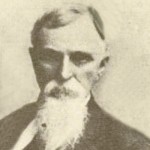 When I first read about the six Knox brothers who were able to place themselves into a family history where they belonged, but in which no one had been able to connect them to before, I was intrigued, for sure. They seemed so resourceful, but I had a feeling that there was a lot more to them than just finding their place in the family history. I’m sure I will come back to these brothers over and over in the future, but when I read about Dr Nicholas C Knox, I was…well, amazed really. This man had the character and fortitude to overcome adversity, and move forward with his life, and in the end, make it better.
When I first read about the six Knox brothers who were able to place themselves into a family history where they belonged, but in which no one had been able to connect them to before, I was intrigued, for sure. They seemed so resourceful, but I had a feeling that there was a lot more to them than just finding their place in the family history. I’m sure I will come back to these brothers over and over in the future, but when I read about Dr Nicholas C Knox, I was…well, amazed really. This man had the character and fortitude to overcome adversity, and move forward with his life, and in the end, make it better.
The fourth son of Absalom Knox MD, Nicholas married Henrietta Craigan. After their marriage, the civil war slammed its way into the midst of their lives. Nicholas enlisted in the Seventeenth Mississippi Regiment, which was commanded by Colonel WS Featherstone, and was a part of McLaw’s Division. Nicholas took part in all the great battles in the Army of Virginia in which his command was engaged, but it was the Battle of Gettysburg that would change his life forever. On the second day of the battle, Nicholas lost his right arm. To make matter worse, he was captured and confined as a prisoner on Hart Island, off the city of New York, for several months before being parolled and sent into the Confederate lines again…without his right arm, and he managed to stay alive during the remainder of the battles he fought in.
During his entire enlistment time in the Civil War, Nicholas was never home…until the day he was discharged. I don’t know if he had been able to tell his wife about his arm, but even if he did, there is nothing like actually seeing it for the first time. It had to be hard for her…and for him. Many soldiers coming home from wars with life changing injuries feel very concerned about just how their spouse will look at them now. They feel like they are a lesser person than they were when they left, and that is just the physical challenges. I’m sure that an injury that cost you your arm, would be a moment that would live in your memory files for the rest of your life.
Nevertheless, Nicholas was not a man to let adversity take his life or his future from him. He returned to Mississippi, and he started the task of rebuilding his life, and getting reacquainted with his family. He started out by teaching school. Now most people would think that was a noble profession, and they would be right, but 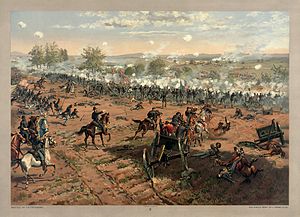 it was not enough for Nicholas. While teaching school, he began to study medicine, and received a diploma from a medical college at Nashville, Tennessee. When I think about the challenges of being a doctor in post Civil War America, with only one arm, and during a time when prosthetics were primitive at best, I am amazed. Still, Nicholas was not satisfied. He entered politics, and represented his county in the Legislature, and afterward was a practitioner of medicine in Reynolds, Mississippi, and he was an elder in the Presbyterian Church. No matter what challenges hit Nicholas, he met them head on, and succeeded in every endeavor he took on. He was not a man content to settle on the ordinary. He was truly an amazing man.
it was not enough for Nicholas. While teaching school, he began to study medicine, and received a diploma from a medical college at Nashville, Tennessee. When I think about the challenges of being a doctor in post Civil War America, with only one arm, and during a time when prosthetics were primitive at best, I am amazed. Still, Nicholas was not satisfied. He entered politics, and represented his county in the Legislature, and afterward was a practitioner of medicine in Reynolds, Mississippi, and he was an elder in the Presbyterian Church. No matter what challenges hit Nicholas, he met them head on, and succeeded in every endeavor he took on. He was not a man content to settle on the ordinary. He was truly an amazing man.
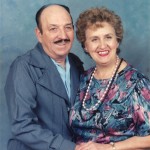 As we were going through our parents things after the passing of our mother, we came across several very old maps of different states, and also one that I received of London during World War II. It occurred to me that my sisters and I are a real novelty these days, in that we know how to read a map, and plan out a route to travel to anywhere we would like to go. I’m sure there are other people out there who can read maps too, but in this day and age of the GPS, many people can’t either. I’m all for technology, and I have a GPS myself, but I can also read a map, and that is because of my dad, and his determination to teach us that art.
As we were going through our parents things after the passing of our mother, we came across several very old maps of different states, and also one that I received of London during World War II. It occurred to me that my sisters and I are a real novelty these days, in that we know how to read a map, and plan out a route to travel to anywhere we would like to go. I’m sure there are other people out there who can read maps too, but in this day and age of the GPS, many people can’t either. I’m all for technology, and I have a GPS myself, but I can also read a map, and that is because of my dad, and his determination to teach us that art.
Every year our family would take a vacation. Sometimes we didn’t travel very far, like the year we took a Wyoming tour, in several separate legs over the course of two weeks. Other times, we traveled quite a ways, like the years we went to visit our sister, Cheryl Masterson, while she was living in upstate New York. As students go, we were a novelty too, because every year when the teacher asked the inevitable question about what we did over the summer, we always had a story to tell. At the time, we didn’t 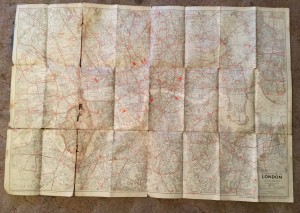 realize just how blessed…and how traveled we were, compared to other students in class. I always thought that everyone took a vacation, but that isn’t so. Many kids got to go visit a grandparent or some other relative, but going to the same place every summer isn’t really a vacation.
realize just how blessed…and how traveled we were, compared to other students in class. I always thought that everyone took a vacation, but that isn’t so. Many kids got to go visit a grandparent or some other relative, but going to the same place every summer isn’t really a vacation.
Our parents were so excited about our vacations every year, and we would often sit down and Dad would show us the route we were going to take on our trip. It was during these vacation planning sessions, that we learned to read a map, and that we learned to enjoy reading a map. The map was never confusing or complicated to us, because Dad showed us how to read it. We knew the difference between an interstate and a state highway. We knew how to pick out the larger cities, as opposed to the small towns. We knew what states and what towns we would be traveling through, and we knew how to find the sights that were located in the area that might be of interest. We knew how to find campgrounds in the area, and how to figure out how far we could easily travel in a days time. All these things are on a map, if you know where to look for them, and thanks to our dad, we did.

I suppose that many people wouldn’t think of a map as a treasure, but for my sisters and me, they really were. We all had to have some of them, and every time we look at them, they will serve as a reminder of those planning sessions, and of all those amazing vacations we took as kids, with our parents. I have no problem with the convenience of a GPS, and in the big cities my husband Bob and I travel to, they are a great help, but if my GPS ever failed, I could still get us there with a map. It is a legacy that our dad left for his daughters. It does make us a novelty, but it is something we are all proud to be able to do, and thankful that we had the parents we had. Their interest in travel, and Dad’s teachings on maps clearly enriched our lives.
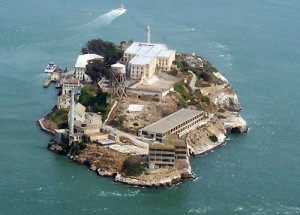 On a trip to San Francisco, my husband, Bob and I took a tour of Alcatraz Prison. I expected it to be a usual touristy place, even though it had been the nation’s end of the line maximum security prison. It was where they sent the most incorrigible inmates. When we arrived, the island known as The Rock or America’s Devil Island to the inmates who did time there, really looked more like an industrial island than a prison, but you could see why it was called The Rock. Of course, that first view of the island was the last time I thought it didn’t look like a prison.
On a trip to San Francisco, my husband, Bob and I took a tour of Alcatraz Prison. I expected it to be a usual touristy place, even though it had been the nation’s end of the line maximum security prison. It was where they sent the most incorrigible inmates. When we arrived, the island known as The Rock or America’s Devil Island to the inmates who did time there, really looked more like an industrial island than a prison, but you could see why it was called The Rock. Of course, that first view of the island was the last time I thought it didn’t look like a prison.
Upon stepping inside, you felt an immediate, almost claustrophobic sensation, and I’m not claustrophobic. The cells were often painted black inside. It was a way of achieving privacy for the inmate. To me it just seemed bleak. I could imagine how it must have been…knowing that you could not leave this dark and ominous place. Alcatraz operated from the mid 1930s to the mid 1960s, and housed over 200 inmates. Well known for it’s brutal conditions, Alcatraz was thought to be inescapable due to the frigid waters of the bay. One group of prisoners either died or proved the rumors wrong, when they escaped and were never heard from again. Their fate is still unknown. The prisoners had to comply with very strict rules, and were required to live in complete silence. The first metal detectors were used at Alcatraz. No wonder the prisoners considered escape, knowing it meant almost certain death. Eventually, the conditions and treatment of the prisoners were deemed cruel and unusual punishment, and on March 21, 1963.
First explored by Juan Manuel de Ayala in 1775, it was originally called Isla de los Alcatraces, which meant 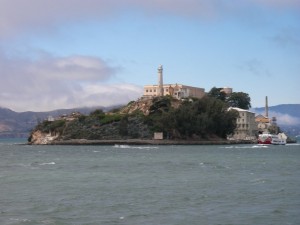 Island of the Pelicans. It was sold to the government in 1849. The first lighthouse in California was on Alcatraz. It was once a Civil War fort and then a military prison in 1907. Finally it became the maximum security prison known as The Rock. After it’s closing, a group of Sioux Indians claimed that the island belonged to them due to a 100 year treaty. Those claims were ignored until November of 1969 when a group of Native Americans representing the American Indian Movement, or AIM occupied the island. They stayed until 1971 when they were finally forced off of the island by federal authorities. The next year it was added to the Golden Gate National Recreation Area and opened for tourism. It was a very interesting tour to say the least.
Island of the Pelicans. It was sold to the government in 1849. The first lighthouse in California was on Alcatraz. It was once a Civil War fort and then a military prison in 1907. Finally it became the maximum security prison known as The Rock. After it’s closing, a group of Sioux Indians claimed that the island belonged to them due to a 100 year treaty. Those claims were ignored until November of 1969 when a group of Native Americans representing the American Indian Movement, or AIM occupied the island. They stayed until 1971 when they were finally forced off of the island by federal authorities. The next year it was added to the Golden Gate National Recreation Area and opened for tourism. It was a very interesting tour to say the least.
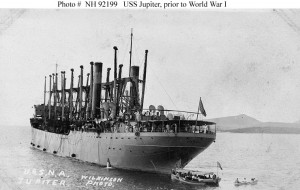 Following the first successful airplane flight by the Wright brothers on Dec 17, 1903, the world changed dramatically…as did the way we fought wars. Of course, just because the Kitty Hawk broke free of the gravitational pull of Earth on that day, did not mean that we went straight to jets. Nevertheless, by the 1920s, airplanes were more common. With this change in travel and maneuverability, came the ability to use these new weapons in warfare. While it took time to develop airplanes to the ability needed to use in a war, in all reality, warfare was forever changed on that day.
Following the first successful airplane flight by the Wright brothers on Dec 17, 1903, the world changed dramatically…as did the way we fought wars. Of course, just because the Kitty Hawk broke free of the gravitational pull of Earth on that day, did not mean that we went straight to jets. Nevertheless, by the 1920s, airplanes were more common. With this change in travel and maneuverability, came the ability to use these new weapons in warfare. While it took time to develop airplanes to the ability needed to use in a war, in all reality, warfare was forever changed on that day.
The United States quickly became interested in aerial warfare, and began work on developing the planes and providing training for the pilots who would fly them. In August of 1910, Jacob Earl Fickel did the first experimenting, with Glenn Curtiss shooting a gun from an airplane. At that time, planes couldn’t easily fly across oceans like they can now, so if they were to be used in warfare, they would have to be transported to the war zone somehow. That brought about the expirements to see if it was practical to take off and land on a ship. I have to wonder just how many failed attempts they had before civilian pilot Eugene Ely successfully took off from a wooden platform installed on the scout cruiser USS Birmingham on November 14, 1910 near Hampton Roads, Virginia. This exceptional pilot successfully took off, and then landed safely on shore a few minutes later. Several months later on January 18, 1911, he also successfully landed on a platform on the USS Pennsylvania in San Francisco harbor.
Now that they knew it could be done, it was time to find a ship to be the carrier full time. Enter the USS Jupiter. The USS Jupiter was a collier ship, which is a bulk cargo ship, from 1913 to 1920. At that point, it was 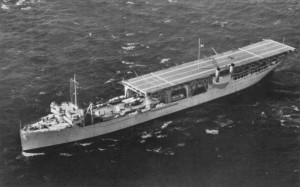 decided that the USS Jupiter would be decommissioned, and converted into the first aircraft carrier in history. Once the work was finished, the USS Jupiter became the USS Langley on April 11, 1920 and was recommissioned as an aircraft carrier on March 20, 1922. Her first executive officer felt right at home on the new ship, because Commander Kenneth Whiting, who was a former submarine commander turned aviator, had been transported to England by the collier Jupiter. Whiting, who earned the title “Father of the Aircraft Carrier,” was the last naval aviator to take training personally from Orville Wright…bringing things full circle so to speak…but the story never really ends does, now does it.
decided that the USS Jupiter would be decommissioned, and converted into the first aircraft carrier in history. Once the work was finished, the USS Jupiter became the USS Langley on April 11, 1920 and was recommissioned as an aircraft carrier on March 20, 1922. Her first executive officer felt right at home on the new ship, because Commander Kenneth Whiting, who was a former submarine commander turned aviator, had been transported to England by the collier Jupiter. Whiting, who earned the title “Father of the Aircraft Carrier,” was the last naval aviator to take training personally from Orville Wright…bringing things full circle so to speak…but the story never really ends does, now does it.
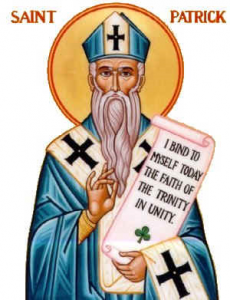 Many holidays get their start on the birth or death of someone famous or very special, and Saint Patrick’s Day is no exception. It was the day that Saint Patrick died in Saul, Ireland. I’m sure that wasn’t surprising to anyone. So, the question then becomes, who was Saint Patrick, and why is he being honored?
Many holidays get their start on the birth or death of someone famous or very special, and Saint Patrick’s Day is no exception. It was the day that Saint Patrick died in Saul, Ireland. I’m sure that wasn’t surprising to anyone. So, the question then becomes, who was Saint Patrick, and why is he being honored?
Saint Patrick was a Christian missionary, bishop, and apostle of Ireland, but that in and of itself was not what made him famous. He lived in a time in history when little would be known of a person’s life if no one took the time to write things down. The Internet, Facebook, and Twitter were far off in the very distant future, so people wrote letters and kept journals. Saint Patrick wrote a book that he titled, “Confessio”, during his last year of life, and it is from these writings that we know what we know of him.
Saint Patrick was born in Great Britain probably in Scotland, to a wealthy Christian family of Roman citizenship. At the age of about 16 years, he was captured be Irish marauders and made to be a slave. For the next six years he worked as a herder in Ireland. Due to the long lonely days, far from family and other human companionship, he drew closer and closer to God for comfort. After hearing a voice in a  dream one night, he escaped and found passage on a ship that took him back to Great Britain and his family. Once he was back with his family, he had another dream. In the dream someone named Victoricus gave him a letter entitled “The Voice of the Irish.” He felt like the Irishmen were pleading with him to go back to Ireland.
dream one night, he escaped and found passage on a ship that took him back to Great Britain and his family. Once he was back with his family, he had another dream. In the dream someone named Victoricus gave him a letter entitled “The Voice of the Irish.” He felt like the Irishmen were pleading with him to go back to Ireland.
In 433, he returned to Ireland, after studying to become an ordained Christian minister and started preaching the Gospel. Thousands of Irishmen were converted to Christianity and many churches were built all around Ireland. After 40 years of devoting his life to God and His work, Saint Patrick died on March 17, 461, in the town of Saul, Ireland, which is where he built his first church.
Since his passing, many legends have grown up about him. He was made the patron saint of Ireland, and 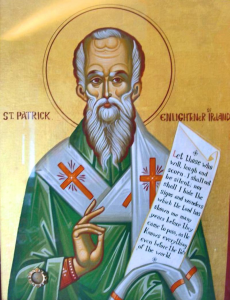 people say that he baptised hundreds of people in a single day. He is also said to have used a three-leaf clover, which became the famous shamrock to describe the Holy Trinity. He is portrayed as trampling snakes because it is said that he had driven them out of Ireland. The Irish observe the day of his passing as a national holiday, attending church in the mornig and celebrating with food and drink in the afternoon. Later the rest of the world jumped on board, and the first Saint Patrick’s Day parade was celebrated in the United States, and involved Irish soldiers serving in the English military marching through the streets of New York City in 1762. The parades became a show of unity and strength for the Irish-American immigrants and the party went global in 1995 when the Irish government started a campaign to matket Saint Patrick’s Day as a way of driving tourists to Ireland. Today, March 17th is still celebrated by millions of people, many of whom probably have no idea what this man stood for. It’s something to think about for sure. Happy Saint Patrick’s Day!!
people say that he baptised hundreds of people in a single day. He is also said to have used a three-leaf clover, which became the famous shamrock to describe the Holy Trinity. He is portrayed as trampling snakes because it is said that he had driven them out of Ireland. The Irish observe the day of his passing as a national holiday, attending church in the mornig and celebrating with food and drink in the afternoon. Later the rest of the world jumped on board, and the first Saint Patrick’s Day parade was celebrated in the United States, and involved Irish soldiers serving in the English military marching through the streets of New York City in 1762. The parades became a show of unity and strength for the Irish-American immigrants and the party went global in 1995 when the Irish government started a campaign to matket Saint Patrick’s Day as a way of driving tourists to Ireland. Today, March 17th is still celebrated by millions of people, many of whom probably have no idea what this man stood for. It’s something to think about for sure. Happy Saint Patrick’s Day!!
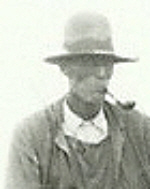 My great grandfather, Cornelius Byer was a friend of the Indians at a time in history, when that was rather uncommon. During his lifetime, the White Man was well known for backing out on treaties as the need or desire for more land warranted, resulting in the pushing back of the Indians further and further off of the land they had been promised. This of course eventually resulted in the placement of the Indians onto reservations, many of which still exist to this day. It also cause much contention between the Indians and the White Man, and of course, the Indian Wars. At that time and even beyond, many Indians did not trust the White Man, even after peace came about, however my great grandfather was a man they not only trusted, but indeed, loved and respected. Over the years, the family would see many times when the Indians would show up at the house, with their whole families in tow. The women and children always waited outside while the men went in to visit with Grandpa about whatever it was they had come for. For the children, I suppose all this seemed normal, but when we look at it in light of history, it seems strange to think of the Indians having such trust and respect for any White Man, and therefore strange to think that they came to the house, and that they were welcomed into it. Nevertheless, this is what happened, and Great Grandpa Byer went to their villages as well.
My great grandfather, Cornelius Byer was a friend of the Indians at a time in history, when that was rather uncommon. During his lifetime, the White Man was well known for backing out on treaties as the need or desire for more land warranted, resulting in the pushing back of the Indians further and further off of the land they had been promised. This of course eventually resulted in the placement of the Indians onto reservations, many of which still exist to this day. It also cause much contention between the Indians and the White Man, and of course, the Indian Wars. At that time and even beyond, many Indians did not trust the White Man, even after peace came about, however my great grandfather was a man they not only trusted, but indeed, loved and respected. Over the years, the family would see many times when the Indians would show up at the house, with their whole families in tow. The women and children always waited outside while the men went in to visit with Grandpa about whatever it was they had come for. For the children, I suppose all this seemed normal, but when we look at it in light of history, it seems strange to think of the Indians having such trust and respect for any White Man, and therefore strange to think that they came to the house, and that they were welcomed into it. Nevertheless, this is what happened, and Great Grandpa Byer went to their villages as well.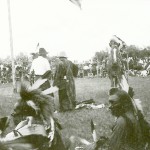
On one such visit to the Indian village of Chief Red Cloud, my grandfather, George Byer was allowed to go along. He recalled that when they entered the tent, Chief Red Cloud was sitting by a fire wrapped in his robe or blanket. Apparently it was customary in this case for him to have little or nothing on underneath that, so I almost have to wonder if it was a sweat lodge or something. Either way, that is what my grandfather recalled as a young boy of about ten years. His dad had gone to visit Red Cloud about something, and in during the visit, the peace pipe was passed around. When it was handed to my grandfather, he was allowed to take it and that resulted in his smoking the peace pipe for the first time as a very young boy, who was apparently considered man enough to do so by the Indians. I doubt if many of us can say, in this day and age, that they know someone who smoked a peace pipe before, but that is the truth.
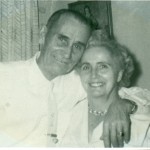
My great grandpa was so greatly respected that not only was he asked to smoke the peace pipe with them, but when he was dying, a rather amazing thing happened. Because he had been their friend, the Indians came to pay their respects. As they had before, they brought their families, but this time the families did not stay outside. The braves came in to shake Great Grandpa’s hand, as did their wives, and their children. Every single one of them shook his hand…from the oldest to the youngest. It was such a moving show of respect for him, and one that was almost never afforded to a White Man. But then, Great Grandpa Cornelius Byer was their friend, and that made him more than just any other White Man. He was like a brother to them.
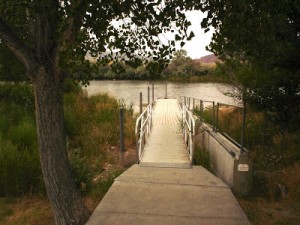 There is a unique place near Thermopolis, Wyoming, that some people in Wyoming know about, or maybe they don’t, but people outside of Wyoming most likely don’t know about it. This place is called Wedding of the Waters. The name might seem to imply that two rivers meet and become one, but that is not the case. In this place located four miles south of Thermopolis, Wyoming, something strange happens. It is the only place I know of where one river flows to a certain point, then changes its name and becomes a completely different river. It isn’t that the river was given a nickname, but rather is completely changes it’s name, like a wife does after her marriage.
There is a unique place near Thermopolis, Wyoming, that some people in Wyoming know about, or maybe they don’t, but people outside of Wyoming most likely don’t know about it. This place is called Wedding of the Waters. The name might seem to imply that two rivers meet and become one, but that is not the case. In this place located four miles south of Thermopolis, Wyoming, something strange happens. It is the only place I know of where one river flows to a certain point, then changes its name and becomes a completely different river. It isn’t that the river was given a nickname, but rather is completely changes it’s name, like a wife does after her marriage.
The way this happened is rather strange. The river begins ninety miles northeast of the actual wedding site. It runs southeast, then winds around to the north and flows through two mountain ranges before joining the Yellowstone River at Bighorn, Montana, 180 miles northeast of the wedding site. From there it eventually reaches the Gulf of Mexico by way of the Missouri and Mississippi Rivers.
When early settlers arrived at the river in what is now the state of Montana, they named it the Bighorn River for the big horn sheep they found near it. Other explorers who found the river south of the wedding site named it the Wind River. Eventually, the people realized that in reality, there was only one river…with two names that had been well established. To avoid confusion, it was decided that a wedding was necessary. That wedding took place, and in fact continues to take place in this quaint little spot known as Wedding of the Waters. The river south of this point is the Wind River, and the river north of this point is the Big Horn River.
The native Indians, mountain men, and early settlers felt like this place was special. I suppose the history of such a compromise made it special. The animals find the place special too, because of the unique vegetation found there. That is mainly due to the warmer water being released from the Boysen Reservoir. Warm thermal spring water adds to the warmth of the water, and it becomes a unique habitat for mule deer, whistling marmots, and mink. The bald eagles are attracted to the rainbow, cutthroat, and brown trout, as well as burbot 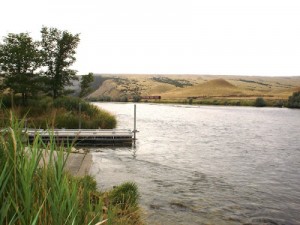 and mountain whitefish. That makes it great for fishermen too. The fish in the river grow quickly because of the many aquatic insects found in the bottom vegetation. And this area even sports the nation’s first handicap-accessible riverine boat ramp that provides drift boat access to the Big Horn River.
and mountain whitefish. That makes it great for fishermen too. The fish in the river grow quickly because of the many aquatic insects found in the bottom vegetation. And this area even sports the nation’s first handicap-accessible riverine boat ramp that provides drift boat access to the Big Horn River.
I think it’s kind of sad that this quaint little spot is so often passed by as if it isn’t even there. I suppose it doesn’t have the advantage of the spectacular canyon scenes just to the south, or the draw of the hot water mineral springs just to the north. Nevertheless, the Wedding of the Waters really is a very special place in its own right, and one that is interesting to go see.
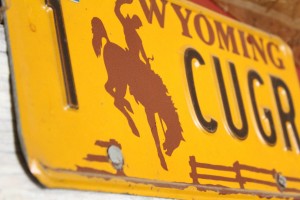
 I don’t know for sure how it all started, but over the years, my father-in-law, Walt Schulenberg collected a number of old license plates that were both unique and average. My guess is that he found one that he really liked, and he saved it, putting it up on the wall of the garage. Before long, the number of plates grew, because there was always another unique license plate to add to the collection. After a while the license plate collection grew to include plates from the different states he had been in, and his son, Ron Schulenberg even brought him some from the countries he was in during Desert Storm…which were quite different from all the others.
I don’t know for sure how it all started, but over the years, my father-in-law, Walt Schulenberg collected a number of old license plates that were both unique and average. My guess is that he found one that he really liked, and he saved it, putting it up on the wall of the garage. Before long, the number of plates grew, because there was always another unique license plate to add to the collection. After a while the license plate collection grew to include plates from the different states he had been in, and his son, Ron Schulenberg even brought him some from the countries he was in during Desert Storm…which were quite different from all the others.
These license plates started out gracing the walls of the garage, which is a fitting place for such a collection, but as time went on, there were enough of then to warrant adding the barn shop my father-in-law had, and finally the back fence to his display areas. In reality, while I found these interesting to look at from time to time, my father-in-law’s license plate was not something that occupied any kind of a special place in my mind. I suppose that if I was a guy, I might have felt differently about it. It is a guy type of collection, after all.
After someone passes away, and you find yourself sorting through all their things, you begin to really get a feel for what was important to them. Not just the major things they had placed a high degree of importance on, but the lesser things too. The things they just liked, because they thought those things were cool. That was how it was for me, when we started going through my father-in-law’s things. No, I can’t say that I wanted those old license plates, but they were interesting. They were a reminder of my father-in-law, and the things he liked.
After the funeral, we took some pictures, as often happens after funerals, simply because many people who come, don’t live here and you want their pictures, because you don’t see them often enough. Many of the people in the family wanted their picture taken by the back fence, showing that collection of license plates. The other day, as I was looking through some of the old pictures, I came across those that were taken that day. It 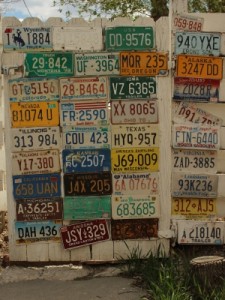
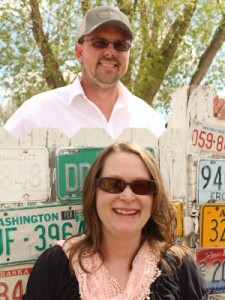 made me think with interest about the array of license plates my father-in-law had collected, and in reality about the kind of man he was.
made me think with interest about the array of license plates my father-in-law had collected, and in reality about the kind of man he was.
The things that were cherished to him were really the life moments. Things like his knife and watch, his tools, his woodworking supplies and chair making supplies, and yes, the license place collection, were things that had a special meaning to him. They were like the stories of his life. They were the accomplishments he had made, the places he had been, and the reminders of just how precious life was. While the license plates were not something I was interested in receiving, I am very glad that I have pictures of them to remember his passion for life.
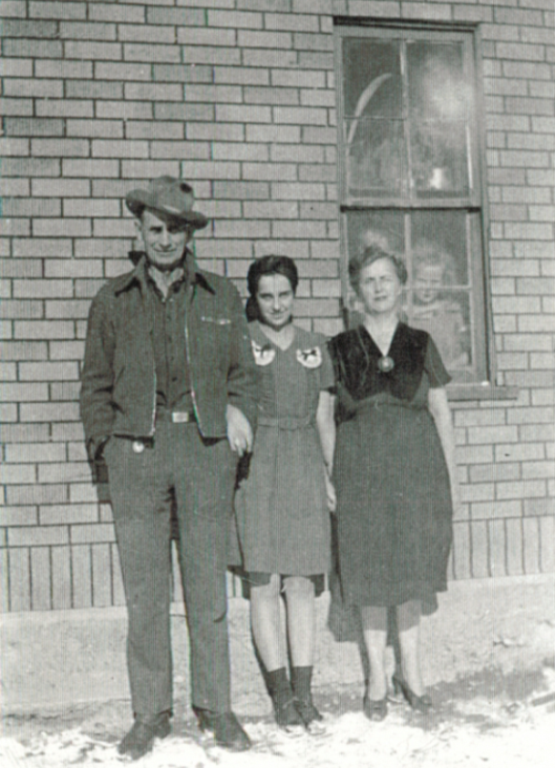 When most people think of the barracks, they think of a military facility, but not so my mother’s family. For all of their childhood, the barracks meant the bedroom. No, it isn’t because that is what they called the bedroom, because, they didn’t call the bedroom that. While visiting with my aunts, Sandy Pattan and Bonnie McDaniels, and cousins Susie Young, Shannon Limmer, and Jamie Patsie, after my mother passed away a week ago, we got on the subject of precious memories…which naturally took us to my grandpa and grandma, George and Hattie Byer’s house in North Casper, where they lived for many years right next door to his mother, my great grandma, Edna Byer. The two houses were very similar, but my grandparents house had an extra, very long bedroom attached to the back of the house. Grandma and Grandpa’s room was in from of that back bedroom, and there was another room where the two boys slept, but the girls all shared that huge back bedroom.
When most people think of the barracks, they think of a military facility, but not so my mother’s family. For all of their childhood, the barracks meant the bedroom. No, it isn’t because that is what they called the bedroom, because, they didn’t call the bedroom that. While visiting with my aunts, Sandy Pattan and Bonnie McDaniels, and cousins Susie Young, Shannon Limmer, and Jamie Patsie, after my mother passed away a week ago, we got on the subject of precious memories…which naturally took us to my grandpa and grandma, George and Hattie Byer’s house in North Casper, where they lived for many years right next door to his mother, my great grandma, Edna Byer. The two houses were very similar, but my grandparents house had an extra, very long bedroom attached to the back of the house. Grandma and Grandpa’s room was in from of that back bedroom, and there was another room where the two boys slept, but the girls all shared that huge back bedroom.
We always loved to go play back there, because it was a long room with lots of beds, and it just seemed very interesting to all the grandkids. I suppose that to the aunts and uncles, it was just normal, be we had really never seen anything like it. We began to talk about what spending the night in that back bedroom was like. There was no heat in that back room, so at night grandpa would heat rocks in the cook stove, and wrap them in a towel. Once the girls were tucked into bed, under a mountain of blankets, grandpa would come in and stick those towel wrapped rocks under the blankets at their feet. What a wonderful thing those rocks were. Aunt Bonnie tells me that they would immediately put their feet on those rocks, and before long, they would be all warm and cozy for the night. In the absence of heat, the blankets and the rocks did the job of keeping them warm quite well.
For us grandkids, the best way to play in that room in the winter cold, was to keep moving. I don’t think my aunts spent much time in there other than sleeping, because it was just too cold in winter. The main living room and kitchen were heated by the cook stove, and I’m here to tell you that those rooms were very warm…a fact that was just fine with me, since I have a tendency to get cold. Nevertheless, after some time in the main part of the house, the cooler bedroom could come as a nice change, until you got cold, then you went back out to the main rooms to warm up.
I had always wondered about the house with the long bedroom, and how it came to be…but no longer. As we were talking about those old days, my Aunt Sandy cleared that question right up. It turns out that both houses, Great Grandma’s and my grandparents, were originally old barracks from the air force base that used to be 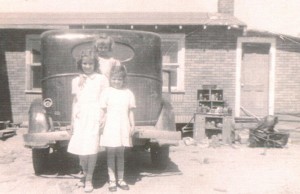 located in Casper. I don’t know for sure when they became the two houses, but that is what happened. My grandparents’ house had the added barracks to it, making up the big back bedroom where so many childhood memories for my mom, aunts, uncles, and many of the grandchildren, were built. In those days, times were tough, and people had to make do with what they had. In my opinion, the barracks and the houses attached to them, were more than just a way to make do. They are the houses I remember fondly from my own childhood years. We used to love going to visit Grandma and Grandpa. The house was always cozy, and my grandparents always pleased to see us. I get a warm cozy feeling just thinking about those visits.
located in Casper. I don’t know for sure when they became the two houses, but that is what happened. My grandparents’ house had the added barracks to it, making up the big back bedroom where so many childhood memories for my mom, aunts, uncles, and many of the grandchildren, were built. In those days, times were tough, and people had to make do with what they had. In my opinion, the barracks and the houses attached to them, were more than just a way to make do. They are the houses I remember fondly from my own childhood years. We used to love going to visit Grandma and Grandpa. The house was always cozy, and my grandparents always pleased to see us. I get a warm cozy feeling just thinking about those visits.
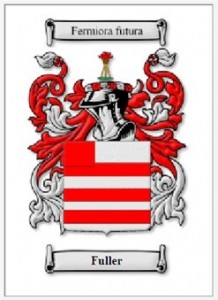 For many people researching the family history means looking for things like famous ancestors, family occupations, historical locations, and eventually the family crest, also known as the Coat of Arms. The problem with the family crest is that there are so many, and the process to make a legal claim to one is difficult, because the right to bear arms in the legal sense of a coat of arms, must be researched and proven through attested Genealogical records. Of course, this doesn’t mean that people can’t pick out a crest that bears their name and use it, even without the legal documentation. They can be displayed as decorative reproductions, derived only from the association with your name. That use, while legal in the sense that you are not committing a crime, is not the legal right to bear arms that is normally associated with the crest.
For many people researching the family history means looking for things like famous ancestors, family occupations, historical locations, and eventually the family crest, also known as the Coat of Arms. The problem with the family crest is that there are so many, and the process to make a legal claim to one is difficult, because the right to bear arms in the legal sense of a coat of arms, must be researched and proven through attested Genealogical records. Of course, this doesn’t mean that people can’t pick out a crest that bears their name and use it, even without the legal documentation. They can be displayed as decorative reproductions, derived only from the association with your name. That use, while legal in the sense that you are not committing a crime, is not the legal right to bear arms that is normally associated with the crest.
Sometimes, for those who are very fortunate, the family coat of arms might be found in a grandparent’s attic, but most of us will not discover our true coat of arms in this manner. Because of the difficulty in locating the necessary information to claim a legal right to a family coat of arms, most people just don’t bother with this part of a full family history. According to LG Pine, author of Heraldry And Genealogy, “At the onset, there is a curious fact in the relationship between the two subjects. While students of Heraldry do take to Genealogy, and acquire a considerable knowledge of it, those who begin as genealogists seldom if ever take any interest in Heraldry. This is most unfortunate, because the two subjects are necessarily related.” I suppose this is true, but once you have stumbled upon a family coat of arms in your research, like I did a few years ago, you simply do become intrigued.
Nevertheless, I had no idea about the legal right to bear arms until I was doing some research into the coat of arms of the Leary side of Bob’s family the other day. I had found several family coats of arms for the Spencer, Byer, Pattan, Fuller, and Schulenberg sides of the family, and planned to look for some of the others in the near future. While I will still do that, I have to wonder about the accuracy of the ones I have, and just how 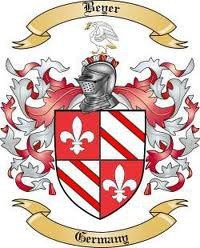 difficult it will be to verify their validity. I can see that I will need to do some research on just how to move forward on this matter in the correct way.
difficult it will be to verify their validity. I can see that I will need to do some research on just how to move forward on this matter in the correct way.
The biggest obstacle I see in researching Heraldry or Genealogy is that the spelling of names changes. Whether it is because the person moved to a new nation and was made to change their name or spelling, or like many people do with their first names these days, the person experimented with the spelling of their last name. William Shakespeare was known to spell his last name Shakespeare, Shakespere, Shakespear, Shakspere, and Shaxpere. So to the researcher, I suppose it would be a matter of searching for documentation under multiple different spellings. You can see that the further you get into a search, the more difficult it is to determine the accuracy. So now apply that to the search concerning the legal right to bear arms, and I think you might have the answer as to why so many people avoid this area of research altogether.

